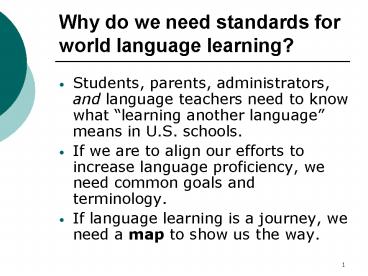Why do we need standards for world language learning? - PowerPoint PPT Presentation
1 / 12
Title:
Why do we need standards for world language learning?
Description:
Why do we need standards for world language learning? Students, parents, administrators, and language teachers need to know what learning another language means ... – PowerPoint PPT presentation
Number of Views:48
Avg rating:3.0/5.0
Title: Why do we need standards for world language learning?
1
Why do we need standards for world language
learning?
- Students, parents, administrators, and language
teachers need to know what learning another
language means in U.S. schools. - If we are to align our efforts to increase
language proficiency, we need common goals and
terminology. - If language learning is a journey, we need a map
to show us the way.
2
What are the different types of standards?
- Content Standards
- What should students know and be able to do?
- Performance Standards
- How can students show they are achieving the
content standards? - Proficiency Standards
- How well are students achieving how can we
measure progress? - Program Standards
- When? Where? Who? the elements of program
design - State Standards Connecting a National Vision to
Local Implementation (PDF) by Paul Sandrock,
ACTFL
3
What are the National Standards for Foreign
Language Learning?
- A brief history
- 1993 work on national foreign language content
standards began - 1996 generic standards published
- 1999 language-specific standards published for
Chinese, Classical Languages, French, German,
Italian, Japanese, Portuguese, Russian, and
Spanish - 2006 added language Arabic
- Standards for Foreign Language Learning in the
21st Centuryhttp//www.actfl.org/i4a/pages/index.
cfm?pageid3324
4
The National Standards 5 Cs
5
Communication
- Communicate in Languages Other Than English
- Interpersonal Mode
- Interpretative Mode
- Presentational Mode
6
Cultures
- Gain Knowledge and Understanding of Other
Cultures
PERSPECTIVES(Meanings, attitudes, values, ideas)
o
PRACTICES(Patterns of social interactions)
PRODUCTS(Books, tools, foods, laws, music, games)
7
Connections
- Connect with Other Disciplines and Acquire
Information - Further knowledge of other disciplines
- Recognize distinctive viewpoints
8
Comparisons
- Develop Insight into the Nature of Language and
Culture - Compare language studied to their own
- Compare culture studied and their own
9
Communities
- Participate in Multilingual Communities at Home
Around the World - Use the language within and beyond school
- Use language for personal enjoyment and enrichment
10
Instructional Strategies
- Speak in the target language (keep English to a
minimum) - Use real objects to convey meaning
- Teach vocabulary in context
- Try paired and small-group activities
- Focus on communication, not just perfect grammar
- from New Jersey World Language Standards, p. 60
11
Learning Strategies
- Show students how to
- Organize in advance by previewing, skimming, or
reading for the gist - Reflect on what theyve learned
- Summarize
- Ask for clarification or explanation
- from Standards for Foreign Language Learning p.
34
12
Communications Strategies
- Circumlocution
- Guessing intelligently
- Deriving meaning from context
- Understanding, interpreting, and producing
gestures - Asking for and providing clarification
- Making inferences, predictions, and
generalizations - Drawing conclusions
- from Standards for Foreign Language Learning p.
34

